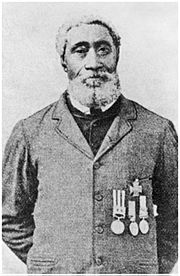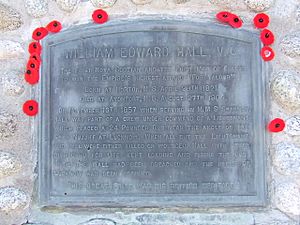William Hall (VC) facts for kids
Quick facts for kids
William Nelson Edward Hall
|
|
|---|---|
 |
|
| Born | 28 April 1827 Horton, Colony of Nova Scotia |
| Died | 27 August 1904 (aged 77) Avonport, Nova Scotia, Canada |
| Buried |
Hantsport Baptist Church Cemetery, Nova Scotia
|
| Allegiance | |
| Service/ |
|
| Years of service | 1847–1876 |
| Rank | Quartermaster |
| Battles/wars | Crimean War |
| Awards | Victoria Cross |
William Nelson Edward Hall (born April 28, 1827 – died August 27, 1904) was a brave sailor. He was the first Black person, the first person from Nova Scotia, and the third Canadian to receive the Victoria Cross. This is the highest award for bravery in the British military.
He earned this medal for his actions during the Siege of Lucknow in 1857. This event was part of the Indian Rebellion. During the battle, Hall and another officer kept firing a large gun. They continued even after everyone else in their group was hurt or killed.
Contents
Early Life and Family History
William Edward Hall was born in 1827 in Horton, Nova Scotia. His parents were Jacob and Lucy Hall. They had escaped from slave owners in Maryland, United States, during the War of 1812. The British Royal Navy helped them find freedom in Nova Scotia. This was part of a movement that brought many Black refugees to Canada.
The Hall family first lived in Summerville, Nova Scotia. Jacob worked in a shipyard there. Later, they bought a farm across the Avon River at Horton Bluff. William first worked in shipyards in nearby Hantsport, Nova Scotia. When he was seventeen, he began working on ships at sea. He sailed on merchant ships from the Minas Basin, including one called the Kent.
William Hall served briefly in the United States Navy from 1847 to 1849. This was during the Mexican–American War. He served on a ship called USS Ohio.
In February 1852, Hall joined the British Royal Navy. His first ship was HMS Rodney.
Fighting in the Crimean War
Hall fought in the Crimean War in 1854. He served on land with a special group of sailors called a Naval Brigade. They fought in important battles like Inkerman and Sevastopol.
After a short time on HMS Victory, Hall moved to a new ship. This was the frigate HMS Shannon. On this ship, he became the "captain of the foretop." This was an important job on the ship.
Journey to India
In May 1857, the Indian Mutiny began. Hall's ship, Shannon, was escorting soldiers to China. When they reached Singapore, they heard about the fighting in India.
The Shannon then sailed to Hong Kong. From there, it was ordered to Calcutta (now called Kolkata) in India. A group of 450 men from the Shannon formed a brigade. They were led by Captain William Peel. The ship was pulled over 600 miles (965 km) up the Ganges River to Allahabad. Then, the group marched to Cawnpore. They arrived just in time to join the Siege of Lucknow.
Bravery at Lucknow
On November 16, 1857, during the Siege of Lucknow in India, naval guns were moved close to a building called the Shah Nujeff mosque. This mosque was a very important target. One of the gun crews needed an extra person, and Hall bravely volunteered.
The gun crews fired steadily to break down the mosque walls. But the fighters inside shot muskets and threw grenades. Many sailors were hurt or killed. After a while, two guns were ordered to move even closer. Of all the crews, only Able Seaman Hall and Lieutenant Thomas James Young were still able to fight. Everyone else was either killed or wounded.
Together, Hall and Lieutenant Young loaded and fired the last gun. They fired it from less than 20 yards (18 meters) away from the wall. They kept firing until the wall finally broke open. Their incredible bravery was recognized with the Victoria Cross.
Life After the Battle
William Hall stayed in the Royal Navy for the rest of his career. In 1859, he joined the crew of HMS Donegal. On October 28, 1859, he received his Victoria Cross medal. Rear Admiral Charles Talbot presented it to him. This happened while the Donegal was in Queenstown Harbour.
Hall became a Petty Officer First Class. He retired from the navy in 1876. He then returned to his home village in Horton Bluff, Nova Scotia. There, he ran a small farm until he passed away in 1904.
In 1901, King George V (who was a prince at the time) visited Nova Scotia. He saw Hall at a parade, noticed his medals, and spoke with him.
Remembering William Hall
William Hall was first buried in a simple grave without military honors. But in 1954, he was reburied in Hantsport, Nova Scotia. His grave is now marked by a special monument at the Baptist church. A local Royal Canadian Legion branch was even named "The Lucknow Branch" to honor his bravery at Lucknow.
Hall's original Victoria Cross medal was brought back from Britain in 1967. The government of Nova Scotia now keeps it. You can see it on display at the Maritime Museum of the Atlantic in Halifax.
You can also learn about William Hall at the Halifax Citadel and the Black Cultural Centre for Nova Scotia. Canada Post honored him with a special stamp. It was first released on February 1, 2010.
On October 8, 2010, William Hall was named a National Historic Person by the Canadian Historic Sites and Monuments Board. A new plaque was put up in his honor in Hantsport. In November 2010, a road in Hantsport was named the William Hall V.C. Memorial Highway. A sign with his picture is on the road.
The fourth ship in the Royal Canadian Navy's Harry DeWolf class class will be named after William Hall. The ship's construction began in Halifax in February 2021.
Awards and Medals
William Hall received several important awards and medals for his service:
| Ribbon | Description | Notes |
| Victoria Cross (VC) |
|
|
| Crimea Medal |
|
|
| Turkish Crimea Medal |
|
|
| Indian Mutiny Medal |
|
See also
- Nova Scotia Heritage Day



